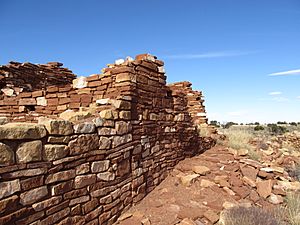Sinagua facts for kids

The Sinagua were an ancient culture that lived in central Arizona a long time ago. They lived there from about 500 CE to 1425 CE. Their land stretched from the Little Colorado River near Flagstaff down to the Verde River near Sedona. This area included the Verde Valley and parts of the Mogollon Rim.
Experts believe the Sinagua people moved to central Arizona from the east around 650 CE. They might have come from the Mogollon culture.
Contents
What Does "Sinagua" Mean?
The name Sinagua was created in 1939 by an archaeologist named Harold S. Colton. He started the Museum of Northern Arizona. The name comes from two Spanish words: sin, meaning "without," and agua, meaning "water."
This name was first used by Spanish explorers for the San Francisco Peaks near Flagstaff. They called these mountains "Sierra Sin Agua" because they were surprised that such big mountains didn't have rivers flowing from them, which is common in Spain.
Two Groups of Sinagua People

Harold S. Colton also noticed that there were two different groups of Sinagua people.
Northern Sinagua
The Northern Sinagua lived in the higher areas around Flagstaff. Some well-known places where you can see their ancient homes include Walnut Canyon National Monument, Wupatki National Monument, and Elden Pueblo.
Southern Sinagua
The Southern Sinagua lived in the lower areas of the Verde Valley. Famous sites open to visitors include Montezuma Castle National Monument, Montezuma Well, Tuzigoot National Monument, Palatki, Honanki Archaeological Sites, and the V Bar V Heritage Site.
How the Sinagua Lived
The Sinagua people got their food in two main ways. They hunted animals and gathered wild plants. They also grew their own crops.
Hunting and Gathering
They hunted many different animals, like antelope, bears, rabbits, turtles, and ducks. They gathered plants like amaranth, ricegrass, and cactus fruit. They also ate sunflowers, hackberry fruit, yucca, wild grapes, walnuts, pine nuts, and acorns.
Farming and Trade
The Sinagua started growing maize (corn) around the 700s. They learned how to irrigate their fields from their neighbors, the Hohokam people. They also grew beans and squash.
In 1064 and 1066, the Sunset Crater volcano erupted. This covered the area with ash, which made the soil much better for farming.
Around 700 CE, the Sinagua also became involved in long-distance trade. They traded their baskets and cotton cloth with people as far away as the Gulf of California and Mesoamerica. In return, they received items like copper, macaws, seashells, salt, and special colors for painting.
Sinagua Homes and Villages
Early Sinagua homes were often large pit houses. These were similar to the homes built by the Hohokam people. They also built wooden buildings. Later, their buildings looked more like the Pueblo architecture seen in other groups in the southwestern United States.
Besides special ceremonial rooms called kivas, their villages had large "community rooms." Some villages even had ballcourts and walled courtyards, much like those of the Hohokam culture.
The last known Sinagua settlement was Montezuma Castle. This amazing 65-room cliff dwelling was built into a limestone cliff by Beaver Creek. It is believed that Sinagua women built this structure between 1100 and 1350 CE.
Sinagua Art and Tools

The Sinagua made pottery called Alameda Brown Ware. They built their pots using a method called paddle-and-anvil. Their clay was usually gray or brown. They mixed it with crushed pottery pieces and painted it with buff, brown, and red colors.
They also carved objects using a type of red stone called argillate, which they got from other areas.
Why Did They Leave?
The Sinagua people left the Verde Valley by the early 1400s. Like other ancient cultures in the Southwest, they seemed to abandon their permanent homes around this time. We don't know the exact reasons why so many people left. Some ideas include:
- Running out of natural resources.
- Long periods of drought (not enough rain).
- Conflicts with new groups of people, like the Yavapai people.
Who Are Their Descendants?
Today, some Hopi clans say their ancestors were part of the Sinagua culture. They believe their ancestors left the Verde Valley for religious reasons. Other groups like the Pima, Tohono O'odham, Yavapai, and Zuni may also have connections to the Sinagua people.
Melanie O'Brien, who works with the National NAGPRA Program, has written about Montezuma Castle. She says there is strong evidence connecting the people of the Verde Valley (from 1125 to 1425 CE) to the Hopi Tribe. This evidence comes from:
- Archaeology: Pottery found at the sites is similar to items made by Hopi people today.
- Anthropology: Studies of human culture and history.
- Linguistics: The study of language.
- Folklore and Oral Traditions: Stories passed down through generations by the Hopi people about events and people at these sites.
Images for kids
-
Montezuma Well is listed in the National Register of Historic Places, reference #66000082.
-
Historic view of the Sinagua cliff dwelling at Montezuma Castle National Monument, 1887
See also
 In Spanish: Cultura Sinagua para niños
In Spanish: Cultura Sinagua para niños








